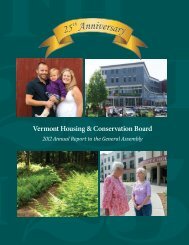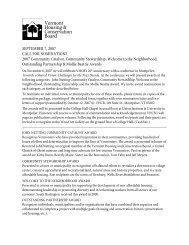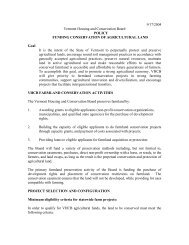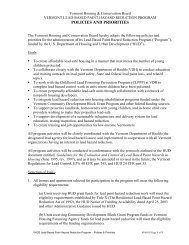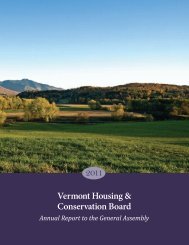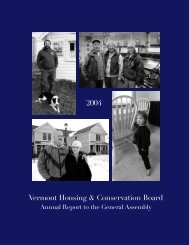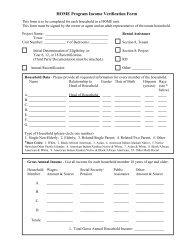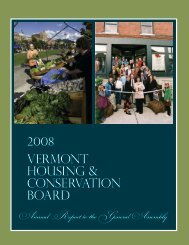Vermont Housing Conservation Board 2005 - Vermont Housing and ...
Vermont Housing Conservation Board 2005 - Vermont Housing and ...
Vermont Housing Conservation Board 2005 - Vermont Housing and ...
You also want an ePaper? Increase the reach of your titles
YUMPU automatically turns print PDFs into web optimized ePapers that Google loves.
VHCB CONSERVATION PROGRAMS<br />
The <strong>Vermont</strong>ers who come before our <strong>Board</strong> seeking funding for conservation<br />
projects share a common trait: foresight. The American Heritage Dictionary<br />
offers a definition of that trait: “concern or prudence with respect to the future.”<br />
When the American Farml<strong>and</strong> Trust polled our grantee farmers several years<br />
ago, it was the desire to see their l<strong>and</strong> continue in agriculture for generations to<br />
come that topped the list of reasons for conserving their farml<strong>and</strong>. We know volunteers<br />
active in perpetuating hiking opportunities who are unable to hike because<br />
their knees have failed them. The elderly tend to be among the most enthusiastic<br />
supporters of local historic restoration projects, believing that our treasured historic<br />
buildings are one of the most important legacies we can leave our children. It’s<br />
foresight that binds these people in the common purpose of conserving the historic<br />
buildings, natural areas <strong>and</strong> open l<strong>and</strong>s that comprise our communites.<br />
You’ll read about the Briggses, the Y<strong>and</strong>ows <strong>and</strong> the O’Connells in this annual<br />
report—all are farmers with unique stories of how VHCB affected their ability to<br />
fulfill aspirations of farming on into the future. Each of these families has wrestled<br />
with the perpetual nature of conservation easements <strong>and</strong> concluded that the right<br />
to develop was an asset they would trade to better position themselves in farming’s<br />
mercurial future.<br />
Other farmers are availing themselves of the Farm Viability Program to augment<br />
their competitive edge in the challenging agricultural economy. Farmers are, by<br />
<strong>and</strong> large, some of the savviest business practitioners in <strong>Vermont</strong>. It’s that innate<br />
abundance of common sense <strong>and</strong> foresight that sends an increasing number of<br />
them to seek help in developing business plans to chart a road map for financial<br />
success.<br />
VHCB <strong>Board</strong> <strong>and</strong> staff continually ask the question “Is this a parcel best<br />
conserved or developed” We look to local expression of foresight to help arrive<br />
at the answer. Thus, considerable weight is given to town <strong>and</strong> regional planning<br />
Fiscal Year <strong>2005</strong><br />
CONSERVATION<br />
State Funding Commitments<br />
Agricultural L<strong>and</strong>:<br />
$2,145,605<br />
19 farms<br />
3,383 acres<br />
Natural Areas, Recreational<br />
L<strong>and</strong>s, Historic Properties:<br />
$1,684,179<br />
22 projects<br />
847 acres<br />
7 historic properties<br />
Federal Funding Programs<br />
Farm <strong>and</strong> Ranchl<strong>and</strong><br />
Protection Program:<br />
$1,921,000<br />
6<br />
VHCB provided funds to the City of<br />
Montpelier to create the new Mill<br />
Pond Park on the North Branch<br />
of the Winooski. Last summer<br />
<strong>Vermont</strong> Youth <strong>Conservation</strong> Corps<br />
members sponsored by the Agency<br />
of Transportation worked with the<br />
City Parks Department l<strong>and</strong>scaping<br />
the park over a two-week period.<br />
In the future, the city hopes to link<br />
the park to the recreation fi elds,<br />
creating a connecting trail system<br />
via a foot bridge across the river.



